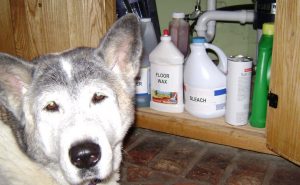
The Animal Poison Control Center receives hundreds of thousands of calls from anxious pet owners each year due to curious noses or frisky paws getting something they should not have. Keeping a safe environment but also knowing what to do once disaster strikes are two obligations every pet owner shares. By taking action before it is needed, you may prevent the worst from happening!
Below are 7 pro-active steps that will not only help your canine or feline best friend live a long, happy and healthy lifetime by your side, but may truly save his life:
- Down on all fours
Look at life from your pet’s perspective. What appears as a nicely appointed room from a 5’ 6” to 6’ 2” viewpoint is a completely different scenario 7” (Chihuahua) to 14” (Old English Bulldog) off the floor! With kitty cats, that can also include counter tops, shelves and other high places! If it’s in paws reach, it’s fair game for even the most obedient canine. Add to that their incredible sniffers! As humans we rarely notice the sweet aroma coming from our morning coffee, yet dogs can detect a spoonful of sugar in an Olympic-sized pool of water! If it smells good, they might investigate more closely and that includes shelves, behind doors and countertops. Cleaners and fertilizers not absorbed through paw pads will be ingested when your pet grooms himself, so take note of what you put on floors and the yard, choosing only pet friendly chemicals.
- Head-to-Tail check
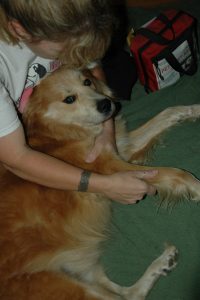
Look your dog or cat over from head-to-tail every week feeling for lumps and bumps. Notice if his skin his dry, his coat dull or shiny, if there is evidence of parasites (flea dirt or the actual critters), burrs or foxtails. Anything you find early (especially a lump) may prevent a nightmare from occurring, so bring it to your veterinarian’s attention at onset. Know your pet’s baseline vitals and pay attention to what he looks like when he stands/sits and how often he asks to go out. The more quickly you spot something ‘not quite right,’ the better chance of fixing it. Never miss annual vet exams as each calendar years is equal to almost 7 years in the life of your pet, meaning a lot can change.
- Pet First Aid & Kit
Emergencies occur without warning, and preventable accidents are the leading cause of death among companion animals. According to the American Animal Hospital Association (AAHA), 25% more pets could be saved if first-aid is administered prior to getting professional care. If you know how to stop bleeding, you can minimize blood loss on the way to the vet. If you know how to lower body temperature, you can prevent brain swelling. If you know how to induce vomiting, you can expel poison before it gets into your pet’s blood stream. If you know how to alleviate choking, you can prevent the dog from going unconscious, and if you know how to administer Cardio Pulmonary Cerebral Resuscitation, you can be the pump your dog’s heart can’t be and possibly save his life! Knowing what to do during those first few moments is empowering as a pet owner but imperative as a pet lover. Knowledge about your breed, for instance being aware that Dobermans, Shepherds and Standard Poodles are more prone to Von Willebrand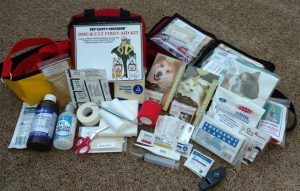 ’s disease, might help you know when a simple bump or fall could evolve into an emergency.
’s disease, might help you know when a simple bump or fall could evolve into an emergency.
Just like a carpenter or plumber, pet owners must have the right tool for the job to rescue Rover or help Fluffy feel better. So that you are prepared to bandage a wound, pull a tick or soothe an upset tummy, at the very least, have the following items, but also remember, if you use something up, replace it. If it expires, get another.
- 3% Hydrogen Peroxide to induce vomiting
- Eye Wash (saline or purified water)
- 4″ X 4″ Gauze Squares and Gauze Roll
- Adhesive Tape of Self-adhering Bandage
- Cold Pack
- Antibiotic Ointment
- Needle-less Syringe or Eye Dropper
- Digital Thermometer (dogs normally run 100.4°-102.5° F)
- Styptic Powder to stop bleeding toe nails
- Scissors & Tweezers
- Antihistamine & Antacid Tablets
- Portable Water Bowl, Bottled Water & Electrolytes
- Leash to wrangle or muzzle a pet (flat faced breeds require a special muzzle)
- Towel or Blanket to wrap an unruly puppy or use as a stretcher
- Phone Numbers/Addresses of your Veterinarian & Animal ER
- Pet First-Aid Handbook
- Animal ER
Drive there before you need to, so that you know where to enter, what services are offered and how they accept payment. Don’t just program the number into your cell. When you have an ill or injured pet, you want to know which side of the street it is on and where the closest entrance is.
- Never Ever Leave a Pet in a Parked Car
No excuses. Don’t do it! That 2-minute run-in to the store, could end up being 10 minutes or more, and in that time…a parked car (with heat radiating up from the concrete or asphalt through the metal) can become fatally hot. If you can’t take your pooch with you on every stop, he’s better off home in a temperate climate, and with that said…make sure he always has plenty of shade. Dogs in fenced yards are trapped as the sun moves and sends shadows across the fence into neighboring yards. Provide Fido a cool place to lay no matter the time of day or season of the year. Cats too should be in a cool temperate environment but those who do go outside have a better chance of finding a cool spot than a dog who is confined to his yard.
- Water Bowl
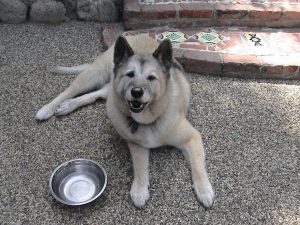
Hydrate early when on walks and during activities. Don’t wait till you reach the top of the hill before offering a drink. Small drinks more frequently are best and never when the dog is panting profusely. Wait till his breathing is regulated to prevent him from gulping air along with the water which could result in bloat. Dogs and cats are 70% water (like us and the planet earth) and need a constant supply of the stuff year round. Some felines won’t drink from a bowl that touches their whiskers and may prefer a glass, coffee mug or tea cup. They also enjoy running water, so how ever you make it available…just make it available all day long!
- Training, Socializing & Exercise
A tired dog is a good dog and an obedience trained, well-socialized pooch knows his manners and is a welcomed member of the family. By teaching “stay” and “leave it,” you increase the chance your dog will remain safe. Border Collies are ever-eager to learn while you may have trouble keeping your Akita’s interest. Know your breed, and work in a manner well-suited to him. Cats need to learn rules like “stay” so that they don’t dash out an open door and “leave it” too!
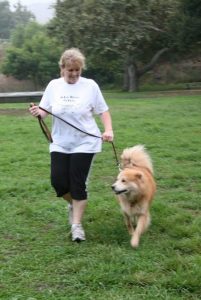 Familiarizing your dog or cat with humans and other animals from an early age, may make him less likely to get in an argument and therefore…not need pet first aid! Getting him comfortable in different environments, to varying ground textures and sounds makes for a stable pup while exercise does a body good – human or canine. It not only keeps joints fluid but provides necessary oxygen to the brain.
Familiarizing your dog or cat with humans and other animals from an early age, may make him less likely to get in an argument and therefore…not need pet first aid! Getting him comfortable in different environments, to varying ground textures and sounds makes for a stable pup while exercise does a body good – human or canine. It not only keeps joints fluid but provides necessary oxygen to the brain.
Pets are part of the family, so follow these tips, and feel empowered knowing you are doing the best you can for your furry family member. Remember to also include quality time spent together daily which means “unplug” when you walk the dog — don’t text or talk on your cell – tune in to your best friend, and be in the moment like he is with you!
Please catch my VLOG on this topic: https://youtu.be/oJuvlheytGQ __________________________________________________________
For 20 years Denise Fleck’s Sunny-dog Ink motto has been “Helping people to help their pets,” and she has…teaching more than 15,000 pet lovers animal life-saving skills and millions more on “The Doctors,” CNN, “Kirstie Alley’s Big Life,” Animal Planet and other TV shows. Denise is a frequent conference speaker, developed a line of pet first aid kits and now offers classes online.
Note: The articles on this page are copyrighted. Please do not reprint or use portions for any purpose without written permission from the author. Request permission for usage by sending an email explaining how you’d like to use the materials and what parts specifically. Thank you in advance!











